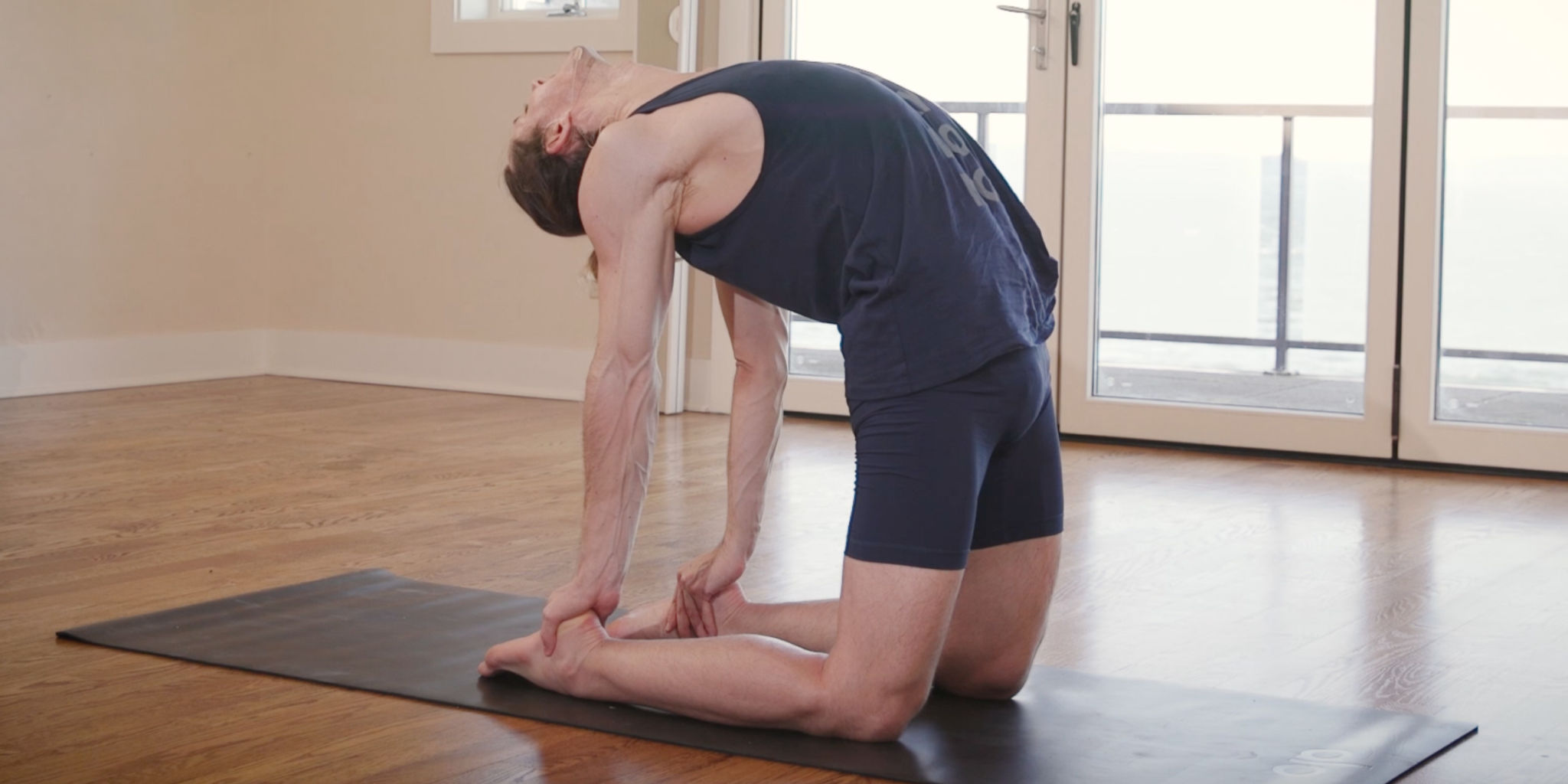
While the passive nature and slow pace of yin yoga might seem like beginner territory, the practice provides many opportunities to challenge even an advanced yogi. The long holds of yin yoga poses require stamina, endurance, and mental focus, while some of the poses themselves open the body to new limits. Below are several advanced yin yoga poses that show you yin isn’t just for beginners.
Advanced Yin Yoga Poses
An important principle in yin yoga is finding your personal edge both physically and mentally in a pose. The goal is to feel sensation in the body (which may be uncomfortable) without pushing past your limits (experiencing pain). As a result, many yin yoga poses have multiple variations so that you can adjust the pose to your needs. Advanced yogis will typically hold poses for 3-5 minutes or more by using props such as blankets, bolsters, or yoga blocks to settle into the posture. Try out these advanced yin yoga poses to find your edge and challenge your practice.
1. Camel
Like many backbends, camel can be difficult both emotionally and physically. Moving the spine in a different direction than normal, the vulnerability of exposing the heart, and the activation of the “fight or flight” response are all challenges that come with this pose. Finding stillness in these challenges can mentally and physically test even an advanced yogi. To come into camel, begin by standing on your knees and placing your hands on the hips. Keeping the hips pushed forward, arch your back and drop the head back if the neck is comfortable. Hands can drop back one at a time to rest on the heels. The full expression of this pose might require a shorter hold of 1-2 minutes due to the strength it requires.
 2. Twisted Dragon
2. Twisted Dragon
Twisted dragon targets many areas simultaneously including the wrists, shoulders, hips, spine, obliques, hamstrings, and the groin. Beginning in downward dog, step one foot between the hands and walk the front foot forward until the knee is right above the heel. Keep the hands on either side of the front foot. Drop the back knee, release the top of the foot and shin to the mat, and slide the leg backward as far as you can. For the twist, the same hand as front knee pushes the knee to the side, while the chest rotates to the sky. Be sure to repeat on the opposite side.
 3. Frog
3. Frog
This intense hip and groin opener requires a great deal of mental focus as it is easy to transfer the tension of this pose to another area of the body (clenched jaw, tensing the shoulders, etc.) To come into the pose, start in child’s pose and slide both hands forward while separating the knees to be in line with the hips. Finally, separate the feet to be in line with the knees.
 4. Saddle
4. Saddle
One of the most challenging poses in yin yoga, saddle is a deep quad stretch that can be very intense on the knees. Starting simply by taking notice of how the knees feel while sitting on the heels is a good first step. Any pain in this position indicates the need to discontinue the pose. If able to go fully into the pose, while still sitting on the heels, open the legs slightly so that you are now sitting between the heels. Lean back onto the forearms to create a small arch in the lower back, and eventually come down fully onto the back. Raising the arms overhead can open the shoulders, stretch the abs, and intensify the stretch in the hip flexors.
 5. Snail
5. Snail
Because this pose puts a lot of pressure on the neck, it is better suited to advanced practitioners who have knowledge of proper alignment and body awareness. Starting by lying on the back, lift the hips and support them with your hands. Allow the back to round and your feet to fall over your head toward the floor. Position the weight of your body onto your shoulders and bend the knees toward the floor (resting next to the ears) for a deeper rounding of the spine.
 6. Squat
6. Squat
This deep squat is an intense hip opener that challenges our normal day-to-day range of motion. Start by standing with the feet hip-width apart. Squat down and bring your arms in front of you, hands in prayer, and elbows applying gentle pressure against the knees or shins. Keeping the feet wide (hip width or more) works into the hips more deeply, while keeping the feet closer together works the ankles more. If you need some extra assistance, grab a block and place it beneath your sit bones.
 7. Toe Squat
7. Toe Squat
While the simplistic appearance of this pose may appear to be beginner level, it can bring up rather intense sensations since our toes and ankles do not typically get as much attention in our practice as the rest of the body. As a result, this pose might require you to start with a 1 minute hold (working up to 2-3 minutes) as opposed to 3-5 minutes like many other poses in yin yoga. Starting in tabletop, tuck all 10 toes under and then gently walk your hands back toward the knees. If you can comfortably sit all the way up, you can simply rest the hands in the lap. This pose offers a perfect opportunity to practice steady breathing as the intensity builds.
For more ways to put your advanced yin practice into action, try Alo Moves‘ Yin for the Hips with Josh Kramer, and their Get Loved Up: Flexibility with Koya Webb which provides lots of variations of intensity for each pose. The advanced full body class in Carling Harps’s Restorative Reset program is another great option to try!
The post Advanced Yin Yoga Poses: Yin Isn’t Just for Beginners appeared first on The Yoga Warrior.
